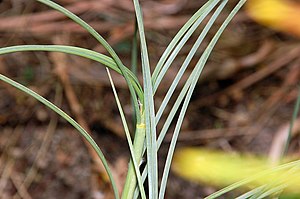Spinifex
| Spinifex | ||||||||||||
|---|---|---|---|---|---|---|---|---|---|---|---|---|

|
||||||||||||
| Systematics | ||||||||||||
|
||||||||||||
| Scientific name | ||||||||||||
| Spinifex | ||||||||||||
| L. |
Spinifex is a genus of plants withinthe sweet grass family (Poaceae). The approximately five species are distributed from tropical to subtropical Asia to Australasia as well as on islands in the southwestern Pacific and are mainly found in Australia.
description
Vegetative characteristics
Spinifex species are compact, perennial plants . They have highly branched, far-reaching stolons . They can also form clumps . They are xerophytes or some halophytes .
The leaves are divided into leaf sheath and leaf blade. The leaf sheaths are loose and open. The ligule is a ciliate border. The leaf blade is relatively long and often silky hairy.
Generative characteristics
Spinifex species are dioecious, separate sexes ( dioecious ).
Inflorescences
Male and female inflorescences are designed very differently. The males are hemispherical, the females spherical. Both consist of bunches of grapes that stand in the axils of long, bract-like bracts. The individual grapes are in the axils of small, double-sided bracts. The clusters of the male plants are stalked, have several spikelets and end in short bristles. The grapes of the female plants have only one spikelet near the base, the rachis of the grape is elongated into a long bristle. The spikelets are two-flowered, rarely single-flowered.
Male spikelets
The glumes are half as long as the spikelet, unequal and three- to nine-veined. They are ovate-elongated, entire and glabrous or hairy. The lemmas of the upper and lower flowers are similar, three- to seven-veined, lanceolate, leathery, glabrous or hairy. The palea are similar to the lemmas, but still clearly two-keeled. The lodiculae are small, broadly ovate, toothed. Each flower contains three stamens . A rudiment of ovary is present.
Female spikelets
The glumes are about the same length as the spikelet, three- to nine-veined, oval to lanceolate, entire, glabrous or hairy. The lemmas of the upper and lower flowers can be the same or different, have three or no nerves, and are glabrous. The lower flower sometimes has no palea, the lodiculae are small. The three stamens are usually small and rudimentary, they rarely produce pollen . In the upper flower the palea is similar to the lemma, the lodiculae are larger. The three stamens are longer and rarely produce pollen. The tip of the ovary is bare and has a long scar .
fruit
The caryopsis is enclosed in the hardened husks, but not fused with it. The embryo is large, the scar punctiform.
Systematics and distribution
The genus Spinifex was established in 1771 by Carl von Linné in Mantissa Plantarum 163, 300. Ixalum G.Forst is a synonym for Spinifex L. nom. nud.
The genus Spinifex belongs to the tribe Paniceae in the subfamily Panicoideae within the family of Poaceae .
The Spinifex species are found in East Asia, the Indomalayan region and Australia . They thrive in open locations. You can attach sand dunes.

There are about five types:
- Spinifex × alterniflorus Nees = nature hybrid of Spinifex hirsutus × Spinifex longifolius : It occurs only in the Australian state of Western Australia .
- Spinifex hirsutus Labill. (Syn .: Spinifex inermis Banks & Sol. Ex Hook. F. ) It thrives on the coasts of the Australian states of Western Australia and South Australia .
- Spinifex littoreus (Burm.f.) Merr. (Syn .: Spinifex squarrosus L. , Spinifex dioicus Buch.-Ham. Ex Dillwyn , Spinifex elegans Buse ): It is widespread from India through East Asia as well as Malaysia to Polynesia and Australia.
- Spinifex longifolius R.Br. (Syn .: Spinifex littoreus var. Longifolius (R.Br.) Backer , Spinifex fragilis R.Br. ): It is distributed from Thailand to Australia.
- Spinifex sericeus R.Br. : It is common from Australia to New Caledonia and New Zealand .
No longer belongs to the genus Spinifex :
- Spinifex paradoxus (R.Br.) Benth. → Zygochloa paradoxa (R.Br.) STBlake
supporting documents
- Spinifex in the Flora of New Zealand
Individual evidence
- ^ Spinifex at Tropicos.org. Missouri Botanical Garden, St. Louis, accessed December 19, 2014.
- ↑ a b c d e Rafaël Govaerts (ed.): Spinifex. In: World Checklist of Selected Plant Families (WCSP) - The Board of Trustees of the Royal Botanic Gardens, Kew . Retrieved December 19, 2014.
- ↑ a b Spinifex in the Germplasm Resources Information Network (GRIN), USDA , ARS , National Genetic Resources Program. National Germplasm Resources Laboratory, Beltsville, Maryland. Retrieved February 4, 2008.
- ^ Flora of New Zealand . , accessed August 10, 2009.
- ^ Spinifex in Grass Genera of the World by DELTA. , accessed August 10, 2009.
- ↑ a b c Spinifex - data sheet at APNI = Australian Plant Name Index . Retrieved December 19, 2014.